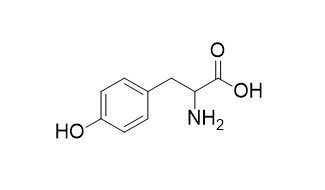DL-Tyrosine
Reference standards.
Inquire / Order:
manager@chemfaces.com
Technical Inquiries:
service@chemfaces.com
Tel:
+86-27-84237783
Fax:
+86-27-84254680
Address:
1 Building, No. 83, CheCheng Rd., Wuhan Economic and Technological Development Zone, Wuhan, Hubei 430056, PRC
Providing storage is as stated on the product vial and the vial is kept tightly sealed, the product can be stored for up to
24 months(2-8C).
Wherever possible, you should prepare and use solutions on the same day. However, if you need to make up stock solutions in advance, we recommend that you store the solution as aliquots in tightly sealed vials at -20C. Generally, these will be useable for up to two weeks. Before use, and prior to opening the vial we recommend that you allow your product to equilibrate to room temperature for at least 1 hour.
Need more advice on solubility, usage and handling? Please email to: service@chemfaces.com
The packaging of the product may have turned upside down during transportation, resulting in the natural compounds adhering to the neck or cap of the vial. take the vial out of its packaging and gently shake to let the compounds fall to the bottom of the vial. for liquid products, centrifuge at 200-500 RPM to gather the liquid at the bottom of the vial. try to avoid loss or contamination during handling.
J Liq Chromatogr R T2018, 41(12):761-769
Phytomedicine.2023, 120:155063.
Mol Med Rep.2022, 25(1):8.
Appl. Sci.2020, 10(20), 7323.
Front Mol Neurosci.2023, 15:1083189.
Yakugaku Zasshi.2018, 138(4):571-579
Biomed Pharmacother.2021, 137:111362.
Phytomedicine Plus2022, 2(1):100207.
Molecules.2023, 28(18):6734.
J Pharm Biomed Anal.2019, 172:268-277
Related and Featured Products
Fluid Phase Equilibria, 2012,314(25):185-197.
Some thermodynamic properties of dl-Tyrosine and dl-Tryptophan. Effect of the ionic medium, ionic strength and temperature on the solubility and acid–base properties.[Reference:
WebLink]
A study on the acid–base properties and solubility of two amino acids, namely DL-Tyrosine and dl-Tryptophan, was carried out in different experimental conditions (ionic medium, ionic strength and temperature).
METHODS AND RESULTS:
The protonation of DL-Tyrosine and dl-Tryptophan was investigated in both (CH3)4NCl and NaCl aqueous solutions by potentiometry (ISE-[H+] glass electrode) in different ionic strength ranges (up to ∼3.0 mol L−1 in (CH3)4NCl and ∼5 mol L−1 in NaCl). Measurements in NaCl were also performed by spectrophotometry at three different temperatures (T = 293.15, 298.15 and 308.15 K). The potentiometric and spectrophotometric data were analyzed altogether in order to obtain reliable protonation constants.Solubility investigations were performed only at T = 298.15 K, in NaCl and (CH3)4NCl aqueous solutions in the ionic strength range investigated for the protonation constants, with the aim to determine the Setschenow coefficient and the activity coefficients of the neutral species of the two amino acids. The dependence of protonation constants on ionic strength was modelled by means of a Debye–Hückel type equation and the SIT approach.
CONCLUSIONS:
The temperature coefficients, in NaCl aqueous solutions, were calculated by using the protonation constants at different temperatures. As a further validation of the data, for the DL-Tyrosine, the ΔH values were also determined by isoperibol calorimetric titrations, at T = 298.15 K, I = 0.15 and 0.5 mol L−1; these values were compared with the ΔH calculated by using the temperature coefficients.
Arch Biochem & Biophys, 1951, 31(3):398-405.
Inhibition of Leuconostoc mesenteroides P-60 by d-tyrosine and its relationship with sodium and potassium content of the medium.[Reference:
WebLink]
METHODS AND RESULTS:
Evidence for a growth inhibition of L. mesenteroides P-60 by the D-isomer of tyrosine was obtained by comparison of the relative activities of L- tyrosine and DL-Tyrosine for this organism, and by comparison of tyrosine assay results obtained on acid and alkaline hydrolysates of casein and beef round. This inhibition is significantly greater on a conventional medium buffered with both Na and K salts than on one containing all of the buffer salts in the K form.
CONCLUSIONS:
Similar studies with L. citrovorum 8081 and Lactobacillus delbrueckii 3 indicate that these organisms are neither inhibited nor stimulated significantly by the presence of D-tyrosine, and are therefore to be recommended as more satisfactory assay organisms for tyrosine whenever the D-isomer is involved in the assays



